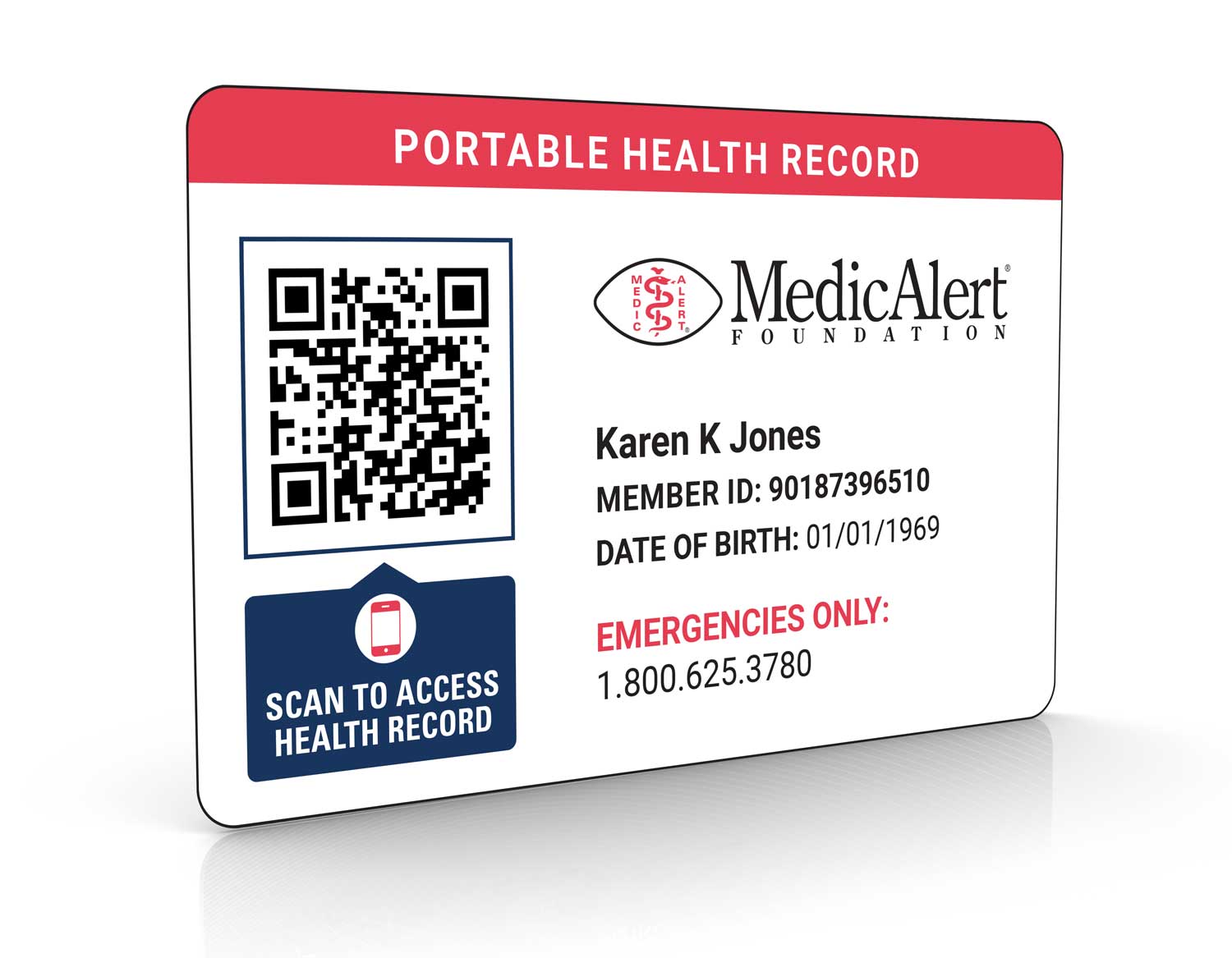Help others help you. Wear a medical alert ID bracelet or necklace engraved with important information for emergency responders and healthcare providers
Centers for Disease Control & Prevention

Medical IDs for Schizophrenia
The confidence to live with Schizophrenia
Schizophrenia is one of the world’s most misunderstood and socially stigmatized mental health disorders. The condition affects a person’s thinking, emotions, and behavior, so it is easily mistaken for other mental health disorders and even excessive drug or alcohol use. The lack of knowledge about schizophrenia and the stigma associated with it can be dangerous for anyone living with the condition.
This is why it is so important for people living with the condition to wear a MedicAlert medical IDs for schizophrenia.
How MedicAlert protects those living with schizophrenia
One thing you shouldn’t worry about is what could happen if there’s an emergency. MedicAlert’s protection plans offer benefits that extend beyond the ID, providing safety and peace of mind for people living with schizophrenia, their families and caregivers.

24/7 Emergency Response
Our team provides first responders the information they need to provide fast, accurate care.

Digital Health Profile
All your vital information, all in one place for you and your caregiver.

Emergency Contact Notification
In an emergency, we connect families so that no one is alone in a crisis.

Patient Instructions
Share the information that’s important to your care, such as use of rescue medications or contraindication for tests like MRIs.
Pair medical IDs for schizophrenia with the protection plan that’s right for you.
What exactly is schizophrenia?
Schizophrenia is a chronic brain disorder that affects approximately 24 million people (0.32% or 1 in 300 people) worldwide. The condition is even rarer in the U.S., affecting less than 1% of Americans nationwide, including an estimated 0.4% of children.
People living with schizophrenia have an altered or distorted perception of reality. This abnormal interpretation of what’s real and what isn’t can lead to extremely disordered thinking, speech, and behavior, hallucinations, and delusions. When schizophrenia is active, symptoms can vary from individual to individual, and in severity.
What causes schizophrenia?
The exact cause of schizophrenia is unknown. However, according to the National Health Service (NHS), research suggests that a combination of genetic, physical, psychological, and environmental factors can make a person more likely to develop the condition. Studies have also shown that people who develop schizophrenia are more likely to have experienced complications during and after birth such as:
- Asphyxia (lack of oxygen) during birth
- Low birth weight
- Premature labor
Additional studies have found that while drugs do not directly cause schizophrenia, drug abuse can increase the risk of developing the condition. The most common drugs associated with an increased risk of schizophrenia include:
- Amphetamines (synthetic mood altering drugs)
- Cannabis (psychoactive drug, affects brain function)
- Cocaine (highly addictive and powerful stimulant drug)
- Lysergic acid diethylamide (LSD) (powerful hallucinogenic drug)
Researchers believe that psychological triggers such as extremely stressful life events could cause schizophrenia to develop in people who are already at risk of developing the disorder. Examples of psychological triggers include:
- Death of a loved one
- Divorce or the end of another relationship
- Emotional, sexual, or physical abuse
- Job loss
- Losing your home
What to engrave on MedicAlert medical IDs for schizophrenia:
MedicAlert offers free custom engraving on all our schizophrenia bracelets and medical ID products. Engravings on medical IDs for schizophrenia should include any critical medical information that can protect and save lives in an accident or medical emergency, for example:
- Schizophrenia
- Current medications
- Designated physician contact information
- Emergency contact information
- Any other details vital to your care

Sample engraving. Consult our team if you need help engraving your medical ID for schizophrenia.
What are the symptoms and complications of schizophrenia?
Schizophrenia is typically diagnosed by ruling out other mental health disorders first and confirming that symptoms are not due to medications, drugs, or a medical condition. This can be accomplished through a physical exam, screening for alcohol and drugs, and imaging studies such as magnetic resonance imaging (MRI) or computed tomography (CT) scan. Your doctor or mental health specialist will also perform a psychiatric evaluation and assess your family and personal history.
When diagnosing schizophrenia, doctors will adhere to the American Psychiatric Association’s (APA) Diagnostic and Statistical Manual, Fifth Edition (DSM-5). Following this protocol enables a safe and accurate diagnosis. In order for a person to be diagnosed with schizophrenia, per the DSM-5, they must:
- Have at least two of five main symptoms of schizophrenia (delusions, hallucinations, disorganized or incoherent communication, disorganized or unusual movements, and negative symptoms).
- Have symptoms that last for at least one month. The condition’s effects (whether or not they meet the full criteria for the symptoms) must also last for at least six months.
- Experience social or occupational dysfunction, meaning the condition disrupts either the ability to work or relationships (friendly, romantic, professional or otherwise).
How do you diagnose schizophrenia?
On average, it takes three years from the time symptoms start before being diagnosed with Sjögren’s syndrome. The condition is often undiagnosed or misdiagnosed because SS symptoms often overlap with or mimic those of other autoimmune conditions, allergies, chronic fatigue syndrome, side effects from medications, and even menopause. Doctors often end up treating each symptom individually, not realizing that collectively, the symptoms are caused by systemic disease.
There is no single test to diagnose Sjögren’s syndrome. However, doctors have a number of tests and evaluation tools that can be used together to reach a definitive diagnosis. These include:
- Lip biopsy to test the salivary glands.
- Blood tests that can detect autoantibodies that often occur in this disease.
- Dental exam, including head, neck, and intraoral evaluation.
- Eye exam to detect and assess for damage on the outer surface of the eyes.
- Physical exam to examine the glands and joints, and assess symptoms.
- Schirmer test to measure the dryness of the eyes.
- Sialometry test to assess decreased saliva production.
How do you treat, manage, and live with schizophrenia?
While there is no sure way to prevent schizophrenia, the disorder can be treated. In many cases, schizophrenia will require lifelong treatment, even when symptoms have diminished. Treatment teams may consist of psychologists, psychiatric nurses, social workers, and case managers to coordinate care. These individuals will have expertise in schizophrenia treatment.
While treatments will vary by individual, the gold standard for treating schizophrenia in both children and adults is medication, particularly antipsychotic drugs (or antipsychotics). Researchers at Mayo Clinic note that the goal of treatment with antipsychotics is to effectively manage the signs and symptoms of schizophrenia at the lowest possible dose. Through trial and error, treatment teams will determine the most effective drug combinations and doses to achieve the best results.
Antipsychotic medications for schizophrenia fall into two categories: first-generation and second-generation. First-generation antipsychotics tend to have more neurological side effects, including the possibility of developing tardive dyskinesia (a movement disorder), which may not be reversible. However, first-generation antipsychotics are less expensive than second-generation antipsychotics, which can be a benefit when long-term treatment is necessary.
Examples of first-generation psychotics include:
- Chlorpromazine (oral or injection, brand names Ormazine, Thorazine, Thorazine Spansule).
- Fluphenazine (Modecate, Moditen, Rho-Fluphenazine).
- Haloperidol (Haldol, Peridol, Haloperidol).
- Perphenazine (Etrafon, Duo-Vil 2-10, Duo-Vil 2-25).
Although they are more expensive, second-generation antipsychotics carry a lower risk of side effects. Because these newer drugs are less risky, treatment teams prefer to prescribe them over first-generation drugs.
Some of the most recognized brand names for second-generation antipsychotics include:
- Abilify (aripiprazole).
- Latuda (lurasidone).
- Rexulti (brexpiprazole).
- Vraylar (cariprazine).
The most commonly prescribed second-generation antipsychotics include:
- Risperdal (risperidone)
- Seroquel (quetiapine)
- Abilify (aripiprazole)
- Clozaril, Versacloz (Clozapine)
- Seroquel (quetiapine)
- Zyprexa (olanzapine)
Other second-generation antipsychotics include:
- Fanapt (iloperidone)
- Geodon (ziprasidone)
- Invega (paliperidone)
- Saphris (asenapine)
Depending on the individual, a doctor or therapist might incorporate other medications such as antidepressants or anti-anxiety drugs, as well as individual or family therapy, and life skills training including social, academic, and vocational.
For adults who do not respond to medications, treatment teams may consider electroconvulsive therapy (ECT). ECT may be helpful for people who are living with both schizophrenia and depression.
Sticking to treatment plans and avoiding alcohol and drugs can help control schizophrenia. In most cases, treatments can help prevent relapses and worsening symptoms, allowing you to get back to living.
How medical IDs for schizophrenia combined with MedicAlert Membership provide peace of mind
If you are living with schizophrenia, a MedicAlert ID and protection plan can become an important part of your lifelong treatment plan. A MedicAlert ID and protection plan can keep you safe in a medical emergency or during crisis periods that require hospitalization by alerting emergency responders and ER doctors of your condition.
A medical ID for schizophrenia and protection plan can also connect emergency responders and your ER team with designated doctors and specialists. A MedicAlert ID and protection plan can even help streamline the check-in process for your regular doctor and specialist visits.
- We’re your voice: If you can’t speak for yourself due to a medical emergency, your ID will speak for you – informing others about your schizophrenia and any medications you’re taking.
- 24/7 emergency protection: In an emergency, the MedicAlert team will relay all of your critical medical information to first responders, no matter where or when your emergency happens.
- Always connected: You should never be alone in an emergency. That’s why MedicAlert will reach out to your designated contacts if you are unable to do so.
- Live with peace of mind and confidence: MedicAlert will be there for you every step of the way. You’ll have the confidence and freedom to live your life with schizophrenia, knowing we’ve got you covered.
DISCLAIMER: THIS WEBSITE DOES NOT PROVIDE MEDICAL ADVICE. The information in this article is presented for educational purposes only and is not intended as a substitute for professional medical advice, diagnosis and treatment. Always seek the advice of a physician or other qualified healthcare provider for any questions you may have regarding a medical condition or treatment.







